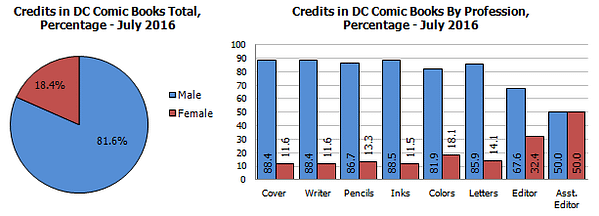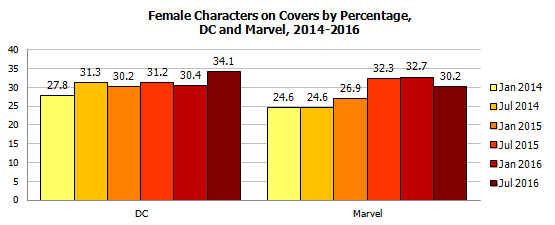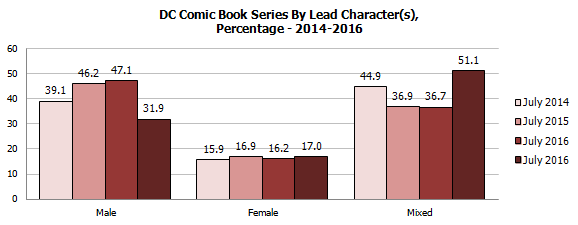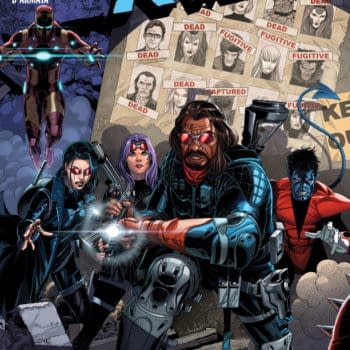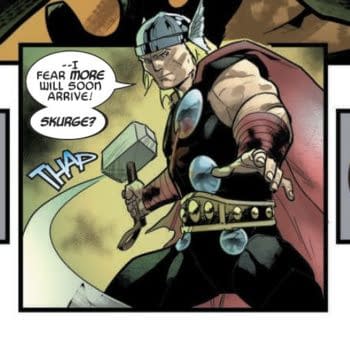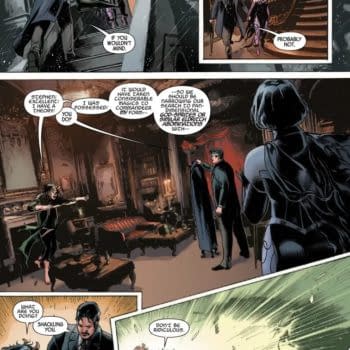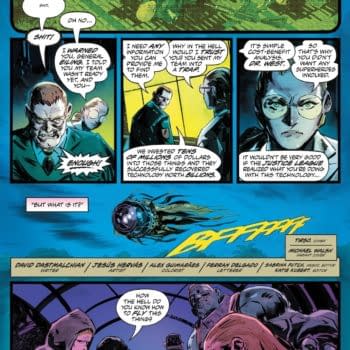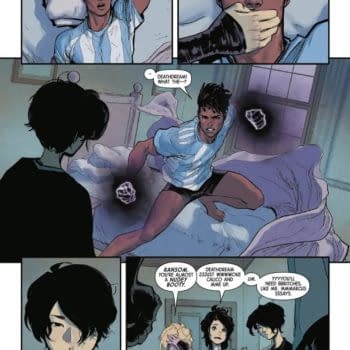Posted in: Comics | Tagged: Comics, dc, entertainment, gendercrunching, marvel
Gendercrunching July 2016 – The Creators And Characters On The Cover Of Marvel And DC Comics
By Tim Hanley
In July 2016, DC's overall percentage of female creators rose for the fourth straight month while Marvel remained noticeably below their recent highs, resulting in DC posting a higher total. We also take a look at the numbers for female characters in the Big Two's comics.
DC COMICS
It was another month with a small gain for DC, and this gradual growth has led to a 5% gain for female creators over the past six months. In July 2016, DC released 62 new comic books with 522 credited creators, 426 men and 96 women. Let's take a look at their stats:
DC's overall percentage of female creators rose 0.9% from last month, not a huge leap but a solid step in a series of gains over the past several months. There were more ups than downs across the board; cover artists, writers, pencillers, inkers, and editors all rose a few points, while colorists and assistant editors dropped a bit. Impressively, every single category was in double digits, a very rare occurrence for the Big Two. After a lot of ups and downs over the past year, DC seems to have settled into a slow but consistent march upward with female representation.
The Past Year at DC: July was DC's biggest month for female creators over the past year:
"Rebirth" seems to be going well for women at DC, or at the very least it's not so male-dominated that it's bringing down the high numbers for female creators DC gets from digital first books, licensed properties, and Vertigo. The limited number of "Rebirth" comics seem to be allowing the rest of DC's line to carry more weight, rather than adding a big boost to the numbers directly.
MARVEL COMICS
Marvel's overall percentage of female creators technically went up in July, but by the smallest of margins. In July 2016, Marvel put out 84 new comics featuring 699 credited creators, 589 men and 110 women. Here are their numbers:
An overall gain of 0.1% isn't much, but at least it's a gain. Marvel remains several points below their recent highs, though. Across the board, there were small gains for cover artists, writers, editors, and assistant editors, while pencillers, inkers, and colorists all fell slightly. Letterers remained the same, yet again, at 0% women. All together, the gains slightly outweighed the losses but by and large the July numbers just looked a lot like June. We may not see a big change from Marvel until the fall and their newest round of Marvel NOW! relaunches.
The Past Year at Marvel: The July total is pretty middle of the road relative to the past year of numbers:
Marvel's always been up and down when it comes to female creators, and while on average things have been slowly moving in a positive direction over the past couple of years, right now Marvel seems to be in the middle of a down swing. The good news is that it's not yet as low as last fall's down swing, which could possibly lead to a higher up swing down the road. It's always a rollercoaster with Marvel.
FEMALE CHARACTERS AT DC AND MARVEL
We're looking at the July numbers, so that means it's time for our biannual check in with female characters at the Big Two. While the focus here is usually behind the scenes, we like to take a look at representation on the page from time to time and see how things are going for the fictional women of the DC and Marvel universes.
We do so by looking at the characters on the covers. Covers are not a perfect distillation of who appears inside the comic book, of course, but they offer a peek at the major players and are the publishers' main means for advertising their books. The methodology is fairly simple: We do a count by gender of the characters on the primary cover of every comic released in July. There are some side rules; for example, anthropomorphic animals count but real ones don't (so Scooby Doo, yes; Krypto, no) and homogeneous crowd scenes get simplified (a group of male ninjas counts as one instead of, say, 27). Finally, the numbers for each issue get turned into a percentage and then all of the percentages are averaged, so each issue carries the same weight.
So here are the numbers for female characters on DC and Marvel's July 2016 covers, going biannually back to January 2014:
This is a rough count, so changes of a percentage point or two are fairly negligible. But DC's percentage of female characters has gone up almost 4%, the biggest swing at DC over the past three years of data leading to their highest total yet. On the one hand, this is an encouraging sign, especially since DC has been pretty stagnant over the past two years. On the other hand, 34.1% is only about a third, and women account for half of the population, so there's a ways to go yet.
At Marvel, their drop of 2.5% is just enough to be slightly more than negligible. While it's not a huge decline, it's enough that it deserves comment. After some low numbers in 2014, Marvel's number of female characters had been on the rise, but their July 2016 numbers took a small step backwards. We'll see in six months if this is was an aberration or a start of a downward trend at Marvel.
Turning to female led titles, let's take a look at how DC and Marvel's lines break down. Each different series was categorized as a male-led, female-led, or mixed team/ensemble book, and every series was counted once. For example, DC's "Rebirth" books that ship twice a month only got one entry. It's about the different series, not how often they come out. We'll start with DC's numbers:
"Rebirth" has brought a few changes for DC. Their number of male-led titles has dropped considerably, with mixed titles making up the difference. Female-led titles were up slightly, but not in any statistically significant way. "Rebirth" seems to mark a new focus on team books, which means increased representation for female characters at DC. Women are typically a minority in team books, but they nonetheless offer a bigger role than male-led series.
Now to Marvel:
Marvel's stayed very consistent over the past six months, with changes so small that they're not statistically significant. This is good news for female-led books, which remain solidly high relative to DC and Marvel's own past showings. There are still more than twice as many male-led series, however, and Marvel remains less interested in team books than DC. Much like with the creator stats above, Marvel NOW! should offer some insights this fall; when we do this count again in January, the outcome, be it changed in some way or the same, will say a lot about Marvel's approach to their characters. These numbers show not much has changed for Marvel over the past six months.
To learn more about this statistics project and its methodology click here, and to see the previous stats click here. You can visit Tim at Straitened Circumstances and follow him on Twitter @timhanley01. His first book Wonder Woman Unbound is available now, and his new book Investigating Lois Lane: The Turbulent History of the Daily Planet's Ace Reporter was released in March 2016.


